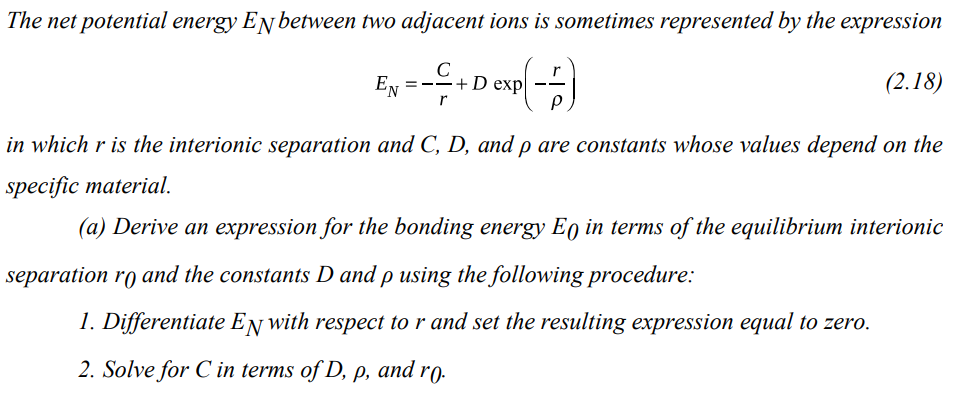The net potential energy EN between two adjacent ions is sometimes represented by the expression C ; - - - + Dexp(-6) (2.18) r EN in which r is the interionic separation and C, D, and p are constants whose values depend on the specific material. (a) Derive an expression for the bonding energy Eo in terms of the equilibrium interionic separation ro and the constants D and p using the following procedure: 1. Differentiate EN with respect to r and set the resulting expression equal to zero. 2. Solve for C in terms of D, p, and ro.
The net potential energy EN between two adjacent ions is sometimes represented by the expression C ; - - - + Dexp(-6) (2.18) r EN in which r is the interionic separation and C, D, and p are constants whose values depend on the specific material. (a) Derive an expression for the bonding energy Eo in terms of the equilibrium interionic separation ro and the constants D and p using the following procedure: 1. Differentiate EN with respect to r and set the resulting expression equal to zero. 2. Solve for C in terms of D, p, and ro.
Elements Of Electromagnetics
7th Edition
ISBN:9780190698614
Author:Sadiku, Matthew N. O.
Publisher:Sadiku, Matthew N. O.
ChapterMA: Math Assessment
Section: Chapter Questions
Problem 1.1MA
Related questions
Question

Transcribed Image Text:3. Determine the expression for Eo by substitution for C in Equation 2.18.
(b) Derive another expression for Eo in terms of ro, C, and p using a procedure analogous
to the one outlined in part (a).

Transcribed Image Text:The net potential energy EN between two adjacent ions is sometimes represented by the expression
C
; - - - + Dexp(-6)
(2.18)
r
EN
in which r is the interionic separation and C, D, and p are constants whose values depend on the
specific material.
(a) Derive an expression for the bonding energy Eo in terms of the equilibrium interionic
separation ro and the constants D and p using the following procedure:
1. Differentiate EN with respect to r and set the resulting expression equal to zero.
2. Solve for C in terms of D, p, and ro.
Expert Solution
This question has been solved!
Explore an expertly crafted, step-by-step solution for a thorough understanding of key concepts.
This is a popular solution!
Trending now
This is a popular solution!
Step by step
Solved in 3 steps with 3 images

Knowledge Booster
Learn more about
Need a deep-dive on the concept behind this application? Look no further. Learn more about this topic, mechanical-engineering and related others by exploring similar questions and additional content below.Recommended textbooks for you

Elements Of Electromagnetics
Mechanical Engineering
ISBN:
9780190698614
Author:
Sadiku, Matthew N. O.
Publisher:
Oxford University Press

Mechanics of Materials (10th Edition)
Mechanical Engineering
ISBN:
9780134319650
Author:
Russell C. Hibbeler
Publisher:
PEARSON

Thermodynamics: An Engineering Approach
Mechanical Engineering
ISBN:
9781259822674
Author:
Yunus A. Cengel Dr., Michael A. Boles
Publisher:
McGraw-Hill Education

Elements Of Electromagnetics
Mechanical Engineering
ISBN:
9780190698614
Author:
Sadiku, Matthew N. O.
Publisher:
Oxford University Press

Mechanics of Materials (10th Edition)
Mechanical Engineering
ISBN:
9780134319650
Author:
Russell C. Hibbeler
Publisher:
PEARSON

Thermodynamics: An Engineering Approach
Mechanical Engineering
ISBN:
9781259822674
Author:
Yunus A. Cengel Dr., Michael A. Boles
Publisher:
McGraw-Hill Education

Control Systems Engineering
Mechanical Engineering
ISBN:
9781118170519
Author:
Norman S. Nise
Publisher:
WILEY

Mechanics of Materials (MindTap Course List)
Mechanical Engineering
ISBN:
9781337093347
Author:
Barry J. Goodno, James M. Gere
Publisher:
Cengage Learning

Engineering Mechanics: Statics
Mechanical Engineering
ISBN:
9781118807330
Author:
James L. Meriam, L. G. Kraige, J. N. Bolton
Publisher:
WILEY